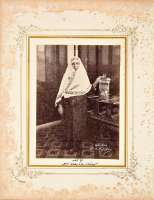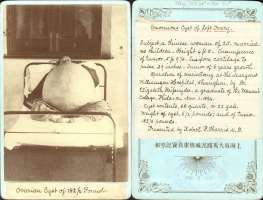Figure 1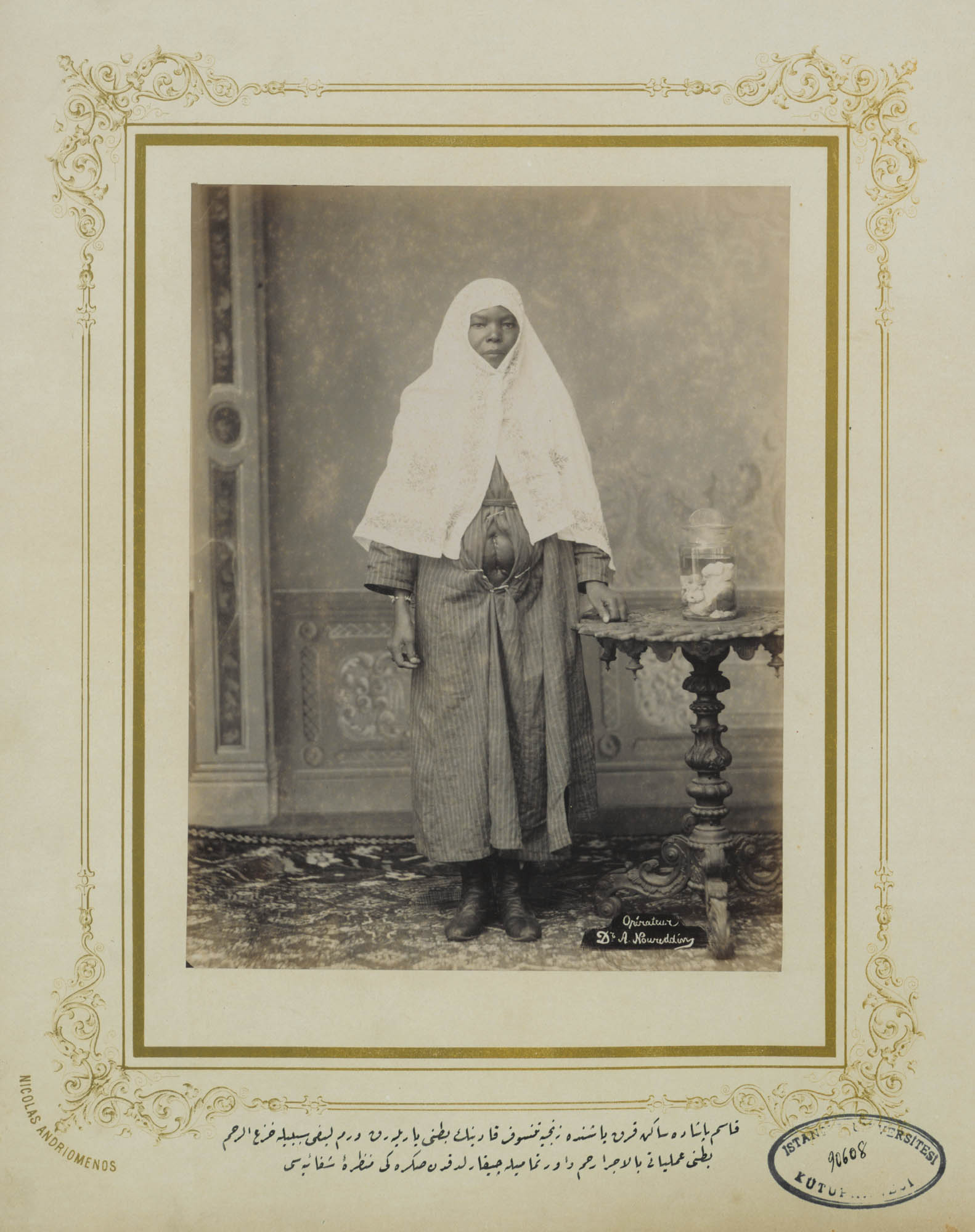 Nicolas Andriomenos. Tensüf
Kadın, ca. 1890–1894. Image 1,
Haseki Women’s Hospital album
formerly part of Abdülhamīd II’s
Yıldız Palace collection. This is
the first photograph in the Haseki
Women’s Hospital album compiled
by Dr. Ahmed Nurrettin and
sent to Sultan Abdülhamīd II.
İstanbul Üniversitesi Nadir
Eserler Kütüphanesi (Istanbul
University Library of Rare Books).p. 37
I still remember the afternoon I encountered the portraits of seven women
who had been treated at Haseki Women’s Hospital (Haseki Nisa Hastanesi),
Istanbul. It was August 2009, and the gold-embossed insignia of Ottoman
Sultan Abdülhamīd II was still perfectly intact on the century-old photo
album’s crimson velvet cover. I could not possibly have known, as I
turned to the first portrait, how much this album (which I will refer to as
the Haseki portrait album) would teach me not only about photography
and late Ottoman healthcare but about how the questions we ask as
scholars shape the answers we discover. The very questions we ask make
some historical experiences discoverable and, unbeknownst to us, obscure
traces of others.
Nicolas Andriomenos. Tensüf
Kadın, ca. 1890–1894. Image 1,
Haseki Women’s Hospital album
formerly part of Abdülhamīd II’s
Yıldız Palace collection. This is
the first photograph in the Haseki
Women’s Hospital album compiled
by Dr. Ahmed Nurrettin and
sent to Sultan Abdülhamīd II.
İstanbul Üniversitesi Nadir
Eserler Kütüphanesi (Istanbul
University Library of Rare Books).p. 37
I still remember the afternoon I encountered the portraits of seven women
who had been treated at Haseki Women’s Hospital (Haseki Nisa Hastanesi),
Istanbul. It was August 2009, and the gold-embossed insignia of Ottoman
Sultan Abdülhamīd II was still perfectly intact on the century-old photo
album’s crimson velvet cover. I could not possibly have known, as I
turned to the first portrait, how much this album (which I will refer to as
the Haseki portrait album) would teach me not only about photography
and late Ottoman healthcare but about how the questions we ask as
scholars shape the answers we discover. The very questions we ask make
some historical experiences discoverable and, unbeknownst to us, obscure
traces of others.
This article tells the story of how I learned to look at these extraordinary
photographs and reflect on the medical care visualized in them. In
what follows, I have deliberately sought to share my process of discovery
rather than present the historical knowledge attained at the end, in the
hopes of encouraging visual research that not only situates visuals in
sociocultural and political contexts but renders visible the construction
of what one might call “the possibility of visual history.”1 Hence I attempt
to share how certain signs on a photographic surface transformed into
clues that sparked my imagination and in turn allowed me to see in ways
not available to me before.
If what follows is a detective narrative of sorts, it is one in which I
have highlighted the moments in which visual detection became possible,
often in conversation with others. This is a detective story focused
less on the discovery at the end and more on the process by which specific
visual details emerged as clues. Humbling as it is to admit, most of
the clues that would emerge over the course of almost a decade of study
were visible to me that afternoon in 2009. But I could neither see them
nor comprehend their significance. This then is a story of how clues
become detectable as clues.2
p. 38 Abdülhamīd II reigned from 1876 to 1909. These were critical and
tumultuous years in Ottoman history. The Haseki portrait album is part
of the rich collection of photographs amassed in Istanbul’s Yıldız Palace
during the sultan’s reign, comprising some 911 albums containing 35,000
photographs.3 However, this particular album (unlike many others in the
collection) is not one that was commissioned by the sultan. Rather, it was
sent to the palace by an ambitious young doctor, Ahmed Nurettin, gynecologist
and obstetrician of Haseki Women’s Hospital.
Haseki Women’s Hospital was a medical institution with a history
going back to the sixteenth century.4 For a while it functioned as a
women’s prison as well. In 1868 it was formally established as a women’s
hospital, the only such institution in the entire Ottoman Empire. At a
time when most women received medical treatment in their homes,
Haseki served mainly homeless and indigent women.5 Medical historian
Gülhan Balsoy details the multiple functions of the hospital, emphasizing
the dual role of Haseki as a place that sheltered and cared for the
most vulnerable Ottoman women while also keeping these unsuitable
women away from public spaces. Haseki Hospital as a social institution
was a site of both care and control, for the patients individually as well
as for the empire. Hence the Haseki portrait album is particularly valuable
as a historical trace of how the visibility and vulnerability of female
patients as both medical and imperial subjects were negotiated.
The Haseki album consists of eight plates. What is perhaps most striking
about the first six is how much they look like classic studio portraits
of the late nineteenth century. In each we can clearly see a woman
directly facing the camera. She stands on a carpet with a stylized studio
backdrop behind her and a decorative table to her side. Each photograph
is mounted onto an ornate mat with the photographer’s name—Nicolas
Andriomenos—imprinted on it. All these details attest to the genre of
this image as a studio portrait. Figure 2 Nicolas Andriomenos. Tensüf
Kadın, ca. 1890–1894. Image 1,
Haseki Women’s Hospital album
formerly part of Abdülhamīd II’s
Yıldız Palace collection. Detail
from the opening image of
the album showing a median
laparotomy scar and the tumor
removed in the surgery. İstanbul
Üniversitesi Nadir Eserler
Kütüphanesi (Istanbul University
Library of Rare Books).
Nicolas Andriomenos. Tensüf
Kadın, ca. 1890–1894. Image 1,
Haseki Women’s Hospital album
formerly part of Abdülhamīd II’s
Yıldız Palace collection. Detail
from the opening image of
the album showing a median
laparotomy scar and the tumor
removed in the surgery. İstanbul
Üniversitesi Nadir Eserler
Kütüphanesi (Istanbul University
Library of Rare Books).
The caption under the first portrait reads, “40 year old negroid [zenciye]
resident of Kasımpaşa, Tensüf Kadın’s ‘picture of health’ following a
median laparotomy resulting in the complete removal of the tumor and
uterus.” Indeed, Tensüf Kadın is wearing a hospital-issued gown carefully
pinned open to reveal the laparotomy scar on her abdomen. And on
the decorative table beside her, in lieu of the typical stack of books or
vase of spring blossoms, is a specimen jar containing the tumor that was
removed from her, thus displaying to her, the photographer, possibly to p. 39 the sultan, and now to us, that which was once internal to her and hence
invisible. That the album opens with a photograph of a black woman is
noteworthy. Tensüf Kadın is the only black female patient in the album
sent to the sultan. The issue of how race is represented in this album and
more broadly in Ottoman photography is outside the scope of this article
but is an important topic that deserves much more research.6
Figure 3 Nicolas Andriomenos.
Müzeyyen Hatun, ca. 1890–1894.
Image 2, Haseki Women’s
Hospital album formerly part of
Abdülhamīd II’s Yıldız Palace
collection. İstanbul Üniversitesi
Nadir Eserler Kütüphanesi
(Istanbul University Library of
Rare Books).Figure 4
Nicolas Andriomenos.
Müzeyyen Hatun, ca. 1890–1894.
Image 2, Haseki Women’s
Hospital album formerly part of
Abdülhamīd II’s Yıldız Palace
collection. İstanbul Üniversitesi
Nadir Eserler Kütüphanesi
(Istanbul University Library of
Rare Books).Figure 4 Nicolas Andriomenos.
Ayşe Hatun, ca. 1890–1894.
Image 3, Haseki Women’s
Hospital album formerly part of
Abdülhamīd II’s Yıldız Palace
collection. İstanbul Üniversitesi
Nadir Eserler Kütüphanesi
(Istanbul University Library of
Rare Books).
Nicolas Andriomenos.
Ayşe Hatun, ca. 1890–1894.
Image 3, Haseki Women’s
Hospital album formerly part of
Abdülhamīd II’s Yıldız Palace
collection. İstanbul Üniversitesi
Nadir Eserler Kütüphanesi
(Istanbul University Library of
Rare Books).
With minor variations, the portraits are all similar: the women appear
in full hospital uniform, all but Tensüf Kadın wear slippers, and each
caption contains detailed information about the patient and what exactly
was removed in the surgical process. Some include the dimensions or
weight of the tumor: Müzeyyen Hatun’s tumor weighed over three kilograms.
Each plate bears the surgeon’s name and title in French visible
in the right-hand corner: “Opérateur Dr. A.
Noureddin.”7 Gülizar Hatun’s portrait is the
exception. Gülizar had a caesarean to remove
the fetus who had died in her womb. She is photographed
without an ornate table, and whether
there is a backdrop behind her or merely a draped
sheet is hard to determine. Hatice Kadın and Adviye
Hatun are posed together. In each of the accompanying
captions, the portraits are described as “a
picture of health.” The image of Misli Hatun is
described as her “asar-ısşifa” (state of healing) after
a twenty-by-thirty-centimeter tumor was removed
through a twenty-five-centimeter incision.
Figure 5 Nicolas Andriomenos or
unknown photographer. Gülizar
Kadın, ca. 1890–1891. Image 4,
Haseki Women’s Hospital album
formerly part of Abdülhamīd II’s
Yıldız Palace collection. “Picture
of health” of twenty-two-year-old
Gülizar Kadın, whose child had
died in the womb, taken after her
caesarean surgery. Gülizar’s case
was communicated to Sultan
Abdülhamīd II by letter from an
Ottoman municipal health officer
the morning after her surgery.
This is the only portrait in the
album showing only the patient.
İstanbul Üniversitesi Nadir
Eserler Kütüphanesi (Istanbul
University Library of Rare Books).Figure 6
Nicolas Andriomenos or
unknown photographer. Gülizar
Kadın, ca. 1890–1891. Image 4,
Haseki Women’s Hospital album
formerly part of Abdülhamīd II’s
Yıldız Palace collection. “Picture
of health” of twenty-two-year-old
Gülizar Kadın, whose child had
died in the womb, taken after her
caesarean surgery. Gülizar’s case
was communicated to Sultan
Abdülhamīd II by letter from an
Ottoman municipal health officer
the morning after her surgery.
This is the only portrait in the
album showing only the patient.
İstanbul Üniversitesi Nadir
Eserler Kütüphanesi (Istanbul
University Library of Rare Books).Figure 6 Nicolas Andriomenos. Hatice Kadın and Adviye Hatun,
ca. 1890–1894. Image 5, Haseki
Women’s Hospital album formerly
part of Abdülhamīd II’s Yıldız
Palace collection. İstanbul Üniversitesi
Nadir Eserler Kütüphanesi
(Istanbul University Library of
Rare Books).Figure 7
Nicolas Andriomenos. Hatice Kadın and Adviye Hatun,
ca. 1890–1894. Image 5, Haseki
Women’s Hospital album formerly
part of Abdülhamīd II’s Yıldız
Palace collection. İstanbul Üniversitesi
Nadir Eserler Kütüphanesi
(Istanbul University Library of
Rare Books).Figure 7 Nicolas Andriomenos. Misli Hatun, ca.
1890–1894. Image 6, Haseki
Women’s Hospital album formerly
part of Abdülhamīd II’s Yıldız
Palace collection. İstanbul Üniversitesi
Nadir Eserler Kütüphanesi
(Istanbul University Library of
Rare Books).
Nicolas Andriomenos. Misli Hatun, ca.
1890–1894. Image 6, Haseki
Women’s Hospital album formerly
part of Abdülhamīd II’s Yıldız
Palace collection. İstanbul Üniversitesi
Nadir Eserler Kütüphanesi
(Istanbul University Library of
Rare Books).
In total, six variations of the phrase “picture of
health” are used: “landscape of health,” “condition
of a scar,” “sign of healing,” “a picture of health,”
“image of convalescence,” and “state of healing.”8
This linguistic care suggests that drawing attention
to the women’s recovered health was a central
purpose of the album. These are not images of
pathology but photographs that visualize successful
medical care. Not only do they render visible
that which was once internal to the body, a novelty
before the invention of X-ray technology in
1895, but these photographs serve as evidence of
the efficacy of medical procedures; these are photographs
of regained health.
Figure 8 Nicolas Andriomenos.
Tumor lineup 1, ca. 1890–1894.
Image 7, Haseki Women’s
Hospital album formerly part of
Abdülhamīd II’s Yıldız Palace
collection. İstanbul Üniversitesi
Nadir Eserler Kütüphanesi
(Istanbul University Library of
Rare Books).Figure 9
Nicolas Andriomenos.
Tumor lineup 1, ca. 1890–1894.
Image 7, Haseki Women’s
Hospital album formerly part of
Abdülhamīd II’s Yıldız Palace
collection. İstanbul Üniversitesi
Nadir Eserler Kütüphanesi
(Istanbul University Library of
Rare Books).Figure 9 Nicolas Andriomenos.
Tumor lineup 2, ca. 1890–1894.
Image 8, Haseki Women’s
Hospital album formerly part of
Abdülhamīd II’s Yıldız Palace
collection. İstanbul Üniversitesi
Nadir Eserler Kütüphanesi
(Istanbul University Library of
Rare Books).
Nicolas Andriomenos.
Tumor lineup 2, ca. 1890–1894.
Image 8, Haseki Women’s
Hospital album formerly part of
Abdülhamīd II’s Yıldız Palace
collection. İstanbul Üniversitesi
Nadir Eserler Kütüphanesi
(Istanbul University Library of
Rare Books).
The final two “group portraits” in the album
might be considered a medical lineup. Jars of tumors
lined up on a table. Each specimen identified by p. 40 type. The first jar, we are told, contains one stone the size of a walnut, the other the size of a hazelnut. The rest are tumors. All were removed
vaginally. That the women from whom these were removed are not photographed
alongside them suggests that the visibility of the surgical scar
is central to the earlier portraits.9 Indeed the bared scar itself is the most
direct site rendering healing visible. That is, we have no reason to doubt
that these patients, too, regained their health, but their scars would not
have been photographable in the same manner. The last page includes
the doctor’s name and title—gynecologist and obstetrician of Haseki
Women’s Hospital and the obligatory term servant (kulları), indicating an
address directly to the sovereign. Captivated by the images, I set out to
understand how and why such an album might have been produced.
p. 41 Upon searching the Ottoman state archives and studying published
histories of the hospital, I soon encountered Dr. Kiryako, the hospital’s
first dedicated doctor, appointed in 1871. The anxieties around the inappropriate
visibility of the destitute women at Haseki were made exceptionally
public in 1882 when a complaint letter bearing seventy-eight
signatures charged the chief doctor, Kiryako, with mistreating the poor
and looking at covered parts of Muslim women when there was no medical
necessity to do so. The accusers wanted the Greek Ottoman, and
hence non-Muslim, Kiryako replaced with an elderly Muslim doctor.
Kiryako was promptly removed from the position he had held for eleven
years while the authorities investigated the allegations against him.10
After a lengthy investigation lasting several years, the authorities decided p. 42 that the allegations were baseless and that Kiryako, though young, was
an excellent doctor.11 He was reinstated in 1885 and remained the chief
doctor of Haseki Hospital until his death in 1890.12 Significantly, one
example of his medical excellence and dedication given in the documents
clearing his reputation was that he photographed surgery patients
before and after surgeries in accordance with scientific norms and even
paid for this photography himself.13
Figure 10 A complaint letter bearing
seventy-eight signatures accusing
Dr. Kiryako of inappropriate
medical behavior at Haseki
Women’s Hospital, Istanbul, 1882.
Başbakanlık Osmanlı Arşivi
(Prime Ministry Ottoman
Archives).
A complaint letter bearing
seventy-eight signatures accusing
Dr. Kiryako of inappropriate
medical behavior at Haseki
Women’s Hospital, Istanbul, 1882.
Başbakanlık Osmanlı Arşivi
(Prime Ministry Ottoman
Archives).
Nurettin, the surgeon whose signature features
heavily in the Haseki portrait album,
arrived at Haseki Hospital as a junior doctor, the
hospital’s third-ranked doctor, in 1890. This was
the year Kiryako died. Faik Bey had succeeded
Kiryako as chief doctor.14 Nurettin was
appointed as a gynecologist and obstetrician. A
photograph from the period shows him seated
just next to Faik Bey, the new chief doctor.15
I strongly suspect that Nurettin knew of the
accusations brought against Kiryako. According
to Nimet Taşkıran’s history of the hospital,
Nurettin’s father, Basri Bey, a naval doctor, had
been appointed to temporarily direct the hospital
during Kiryako’s suspension.16 Four years after
he arrived, Nurettin left Haseki and appears to
have practiced at another hospital under one
of three Ottoman doctors who had been sent
to France for surgical training. He returned to
Haseki Hospital in 1903 as a general surgeon. He
had an illustrious medical career and commanded
much respect in his day. In 1907 he
became chief doctor at Haseki Hospital and held
this position until his death in 1924.
p. 43Figure 11 Abdullah Frères (Abdullah Brothers). Group portrait
of Haseki Women’s Hospital’s
medical staff, ca. 1893. Dr. Ahmed
Nurettin is third from right, front
row. From Hasköy Hospital for
Women, Fountains, Mausoleums,
and Other Buildings and Views,
part of the collection of fifty-one
albums gifted to the Library of
Congress by Abdülhamīd II.
Courtesy Library of Congress. The other protagonist in the story of the Haseki portrait album is
Greek Ottoman photographer Andriomenos, one of the most famous
photographers of the era. Andriomenos had learned photography in the
studio of Kosmi Abdullah, who had his own studio separate from that
of his three brothers, the famous Abdullah Frères who were official
photographers to the sultan. Andriomenos took over Kosmi Abdullah’s
studio in 1879. He was one of the rare photographers who gained access
to the palace and allegedly even gave photography lessons to Sultan
Abdülhamīd’s younger brother, Prince Vahdettin.17
Abdullah Frères (Abdullah Brothers). Group portrait
of Haseki Women’s Hospital’s
medical staff, ca. 1893. Dr. Ahmed
Nurettin is third from right, front
row. From Hasköy Hospital for
Women, Fountains, Mausoleums,
and Other Buildings and Views,
part of the collection of fifty-one
albums gifted to the Library of
Congress by Abdülhamīd II.
Courtesy Library of Congress. The other protagonist in the story of the Haseki portrait album is
Greek Ottoman photographer Andriomenos, one of the most famous
photographers of the era. Andriomenos had learned photography in the
studio of Kosmi Abdullah, who had his own studio separate from that
of his three brothers, the famous Abdullah Frères who were official
photographers to the sultan. Andriomenos took over Kosmi Abdullah’s
studio in 1879. He was one of the rare photographers who gained access
to the palace and allegedly even gave photography lessons to Sultan
Abdülhamīd’s younger brother, Prince Vahdettin.17
I assumed that what I saw in the Haseki portrait album was a visual
medical convention, a genre of medical photography that had later fallen
out of use. I assumed it was a Western medical genre that Dr. Nurettin
had either seen examples of, been told of by other Ottoman doctors who
had been trained abroad, or read about in one of the many foreign medical
journals that circulated in the empire.18 However, a broad survey of
medical historians, archivists, librarians, and medical museum curators
not only in Istanbul but all over North America and Europe yielded no
similar portraits.19 All consulted were surprised by the images and told
me they had never seen anything like it. And by “like it” they meant a
portrait of a live human with something that had been removed from
them, an image in which the once internal was on display. They were
reminded of images of corpses with an organ removed but could not
think of one where the subject of the portrait was still alive, let alone “a
picture of health” or “a landscape of healing,” as Nurettin described the
patients in the Haseki portrait album.
Rather than an Ottoman application of a Western or universal medical
photography, I now understand the Haseki portrait album as a visual
negotiation at a moment when a genre of medical photography had not
yet stabilized.20 New genres do not emerge fully formed but rather must
be crafted from borrowing, reshaping, and repurposing existing forms.
In the absence of an accepted method or style, Nurettin and photographer
Andriomenos drew from the practices and codes
of the existing genres of medical illustration and studio
portraiture.21 However, I arrived at this conclusion
only after appreciating the ways in which they must
have collaborated.
Figure 12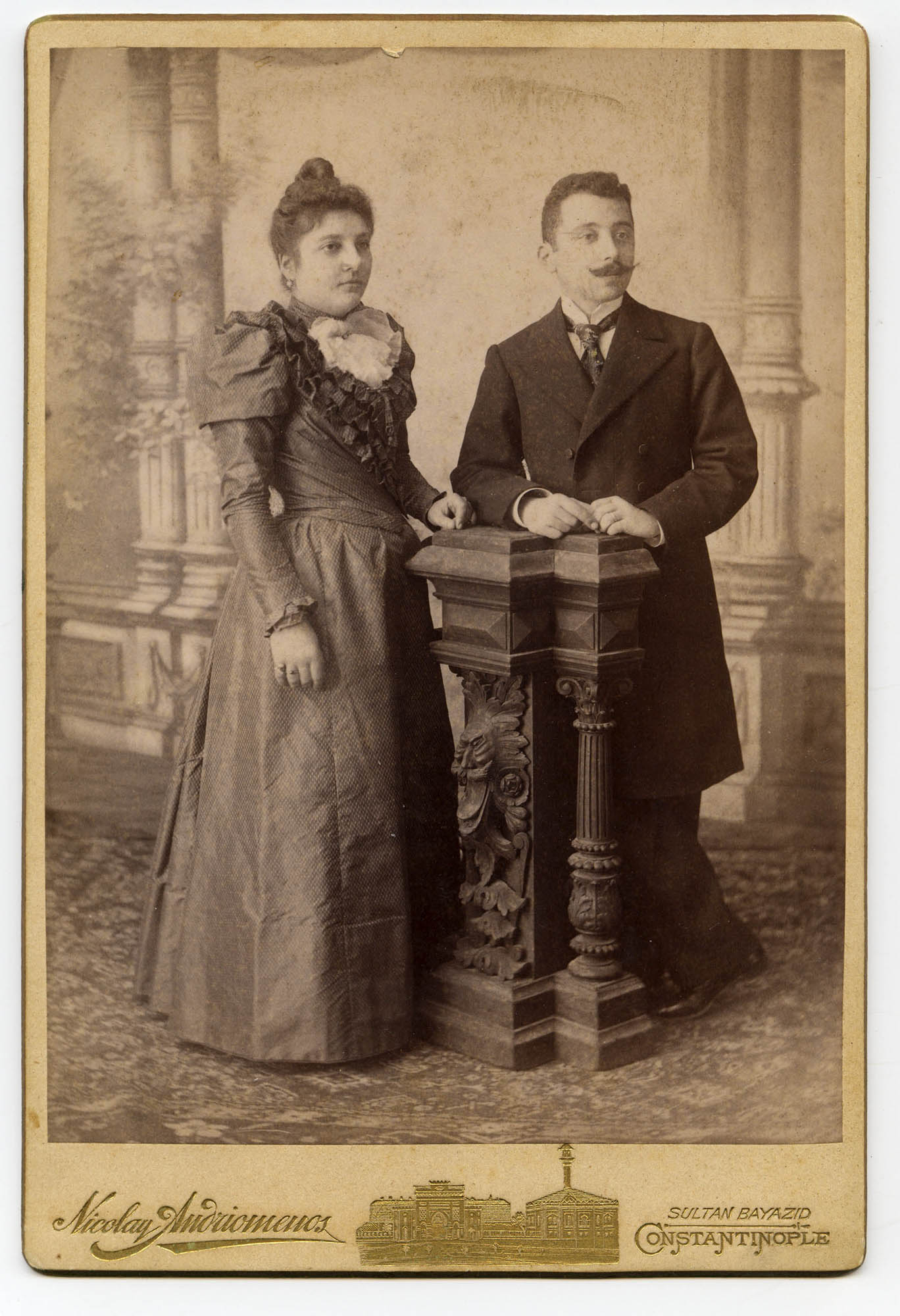 Nicolas Andriomenos. Studio
portrait of a couple, ca. 1879–
1912. The same carpet appears
in photographs from the Haseki
Women’s Hospital album
formerly part of Abdülhamīd II’s
Yıldız Palace collection. Courtesy
Gülderen Bölük.
Nicolas Andriomenos. Studio
portrait of a couple, ca. 1879–
1912. The same carpet appears
in photographs from the Haseki
Women’s Hospital album
formerly part of Abdülhamīd II’s
Yıldız Palace collection. Courtesy
Gülderen Bölük.
My first question was where the portraits of the
patients were taken, and so I searched private photography
collections for portraits taken by Andriomenos
in his studio. First, I recognized the carpet that appeared
in many of the portraits.22 Then one of the collectors
spotted the table in the Haseki portraits. Sure enough, p. 44 here was proof that the carpet and the table in the portraits were from Andriomenos’s studio. That the photographer would come to the hospital
with all this equipment was hard to imagine, but less so than imagining
the women and their tumors being transported to the photographer’s studio.
But then I found a photograph that confirmed the women and their
tumors must have been transported to the studio. In one portrait from the
album, we clearly see the same floor design as in another Andriomenos
studio portrait. Horse-drawn trams began operating in Istanbul in the
1870s and the route from Haseki Hospital to Andriomenos’s Beyazıt studio
was on one of the earliest routes. The distance between the studio and
the hospital was only 1.9 kilometers.23
Figure 13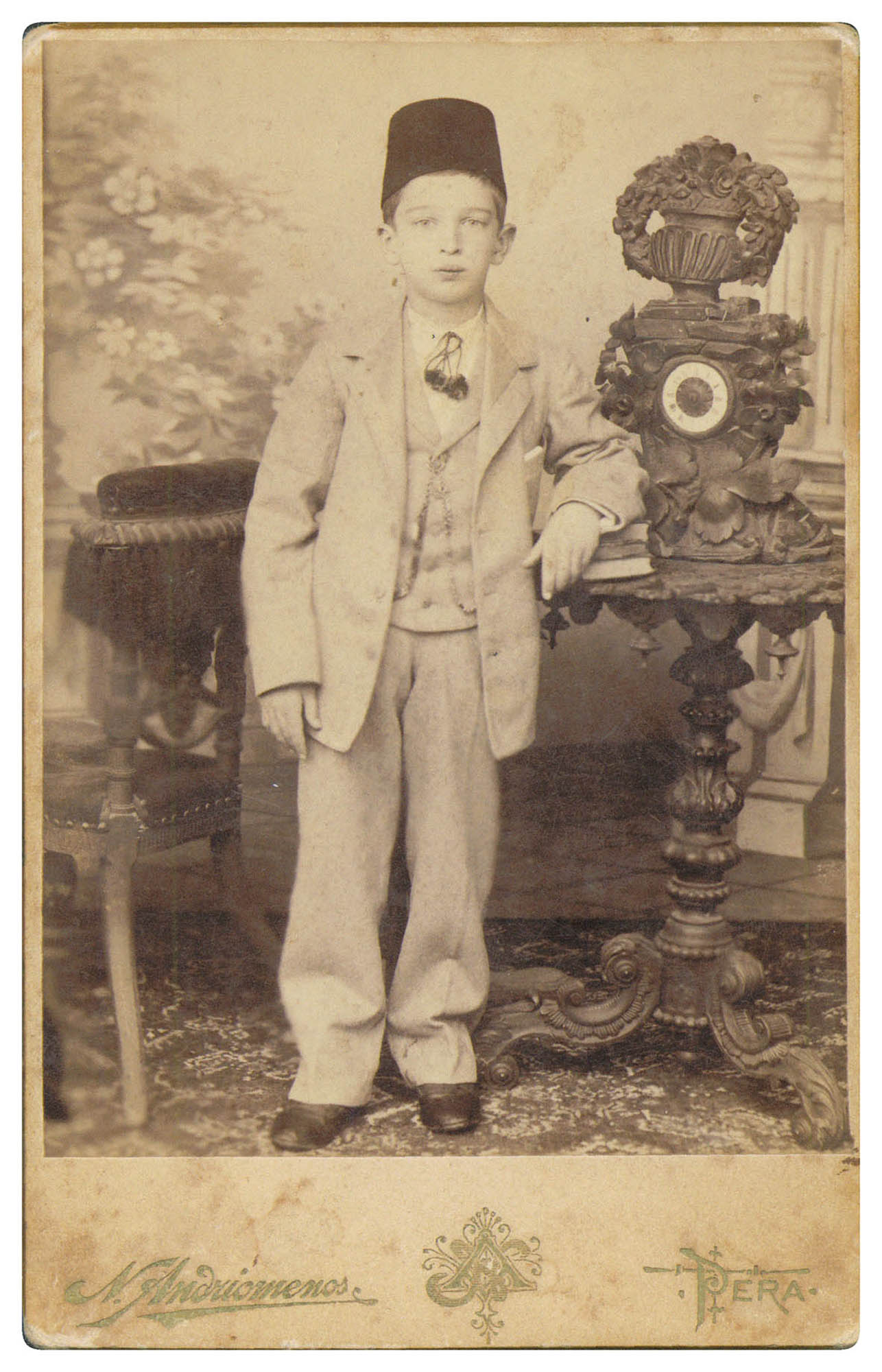 Nicolas Andriomenos.
Studio portrait of a boy, ca.
1879–1912. The same decorative
table appears in photographs
from the Haseki Women’s
Hospital album formerly part of
Abdülhamīd II’s Yıldız Palace collection.
Courtesy Adem Köse.Figure 14
Nicolas Andriomenos.
Studio portrait of a boy, ca.
1879–1912. The same decorative
table appears in photographs
from the Haseki Women’s
Hospital album formerly part of
Abdülhamīd II’s Yıldız Palace collection.
Courtesy Adem Köse.Figure 14 Nicolas Andriomenos.
Studio portrait of a woman, ca.
1879–1912. The same floor
appears in the portrait of Misli
Hatun, image 6 of Haseki
Women’s Hospital album formerly
part of Abdülhamīd II’s
Yıldız Palace collection. Courtesy
Gülderen Bölük.
Nicolas Andriomenos.
Studio portrait of a woman, ca.
1879–1912. The same floor
appears in the portrait of Misli
Hatun, image 6 of Haseki
Women’s Hospital album formerly
part of Abdülhamīd II’s
Yıldız Palace collection. Courtesy
Gülderen Bölük.
Nimet Taşkıran’s history of Haseki Hospital (published in 1972) states
that there was an identical album to the one in Abdülhamīd’s collection
in Yıldız Palace, and in the summer of 2014 I finally located a second
album in a private collection.24 However, it was not identical. The crimson
velvet cover is similar (if significantly more worn), and all of the
images in the sultan’s album are also in this album, but the handwriting
is much less ornate, and the captions include no biographical information
about the women. Instead, only the medical terms for the surgeries
and specific descriptors of the tumors are given, suggesting to me that
this album was prepared by the doctor for himself or another medical p. 45 colleague. Should he want biographical information, Nurettin would be
able to consult the hospitals records for the patients. Moreover, the second
album has seven photographs that were not included in the sultan’s
album. These additional images mostly seem to have been taken at the
hospital itself, though two photographs feature the carpet and decorative
table from the studio. We see the hospital’s bare floor and a stove, but the
women are not uniformly dressed. One image shows two specimen jars.
In another, two women have placed a hand on the same specimen jar, as
if they shared a tumor. Perhaps the two shadows visible behind the woman
in the seventh photograph belonged to the doctor and the photographer.
Figure 17 Nicolas Andriomenos. Woman with two bell jars containing
tumors, ca. 1893–1907.
Image 1, Haseki Women’s Hospital
album, private collection. Photograph not included in the
Haseki portrait album sent to
Yıldız Palace. Courtesy Ömer M. Koç Collection.Figure 18
Nicolas Andriomenos. Woman with two bell jars containing
tumors, ca. 1893–1907.
Image 1, Haseki Women’s Hospital
album, private collection. Photograph not included in the
Haseki portrait album sent to
Yıldız Palace. Courtesy Ömer M. Koç Collection.Figure 18 Nicolas Andriomenos, ca.
1893–1907. Image 2, Haseki
Women’s Hospital album, private
collection. Photograph not included in the
Haseki portrait album sent to
Yıldız Palace. Courtesy Ömer M.
Koç Collection.Figure 19
Nicolas Andriomenos, ca.
1893–1907. Image 2, Haseki
Women’s Hospital album, private
collection. Photograph not included in the
Haseki portrait album sent to
Yıldız Palace. Courtesy Ömer M.
Koç Collection.Figure 19 Nicolas Andriomenos. Two
patients and a single tumor, ca.
1893–1907. Image 3, Haseki
Women’s Hospital album, private
collection. Photograph not included in the
Haseki portrait album sent to
Yıldız Palace. Courtesy Ömer M.
Koç Collection.Figure 20
Nicolas Andriomenos. Two
patients and a single tumor, ca.
1893–1907. Image 3, Haseki
Women’s Hospital album, private
collection. Photograph not included in the
Haseki portrait album sent to
Yıldız Palace. Courtesy Ömer M.
Koç Collection.Figure 20 Nicolas Andriomenos, ca.
1893–1907. Image 4, Haseki
Women’s Hospital album, private
collection. Photograph not included in the
Haseki portrait album sent to
Yıldız Palace. Courtesy Ömer M.
Koç Collection.Figure 21
Nicolas Andriomenos, ca.
1893–1907. Image 4, Haseki
Women’s Hospital album, private
collection. Photograph not included in the
Haseki portrait album sent to
Yıldız Palace. Courtesy Ömer M.
Koç Collection.Figure 21 Nicolas Andriomenos, ca.
1893–1907. Image 7, Haseki
Women’s Hospital album, private
collection. Photograph not included in the
Haseki portrait album sent to
Yıldız Palace. Courtesy Ömer M.
Koç Collection.Figure 22
Nicolas Andriomenos, ca.
1893–1907. Image 7, Haseki
Women’s Hospital album, private
collection. Photograph not included in the
Haseki portrait album sent to
Yıldız Palace. Courtesy Ömer M.
Koç Collection.Figure 22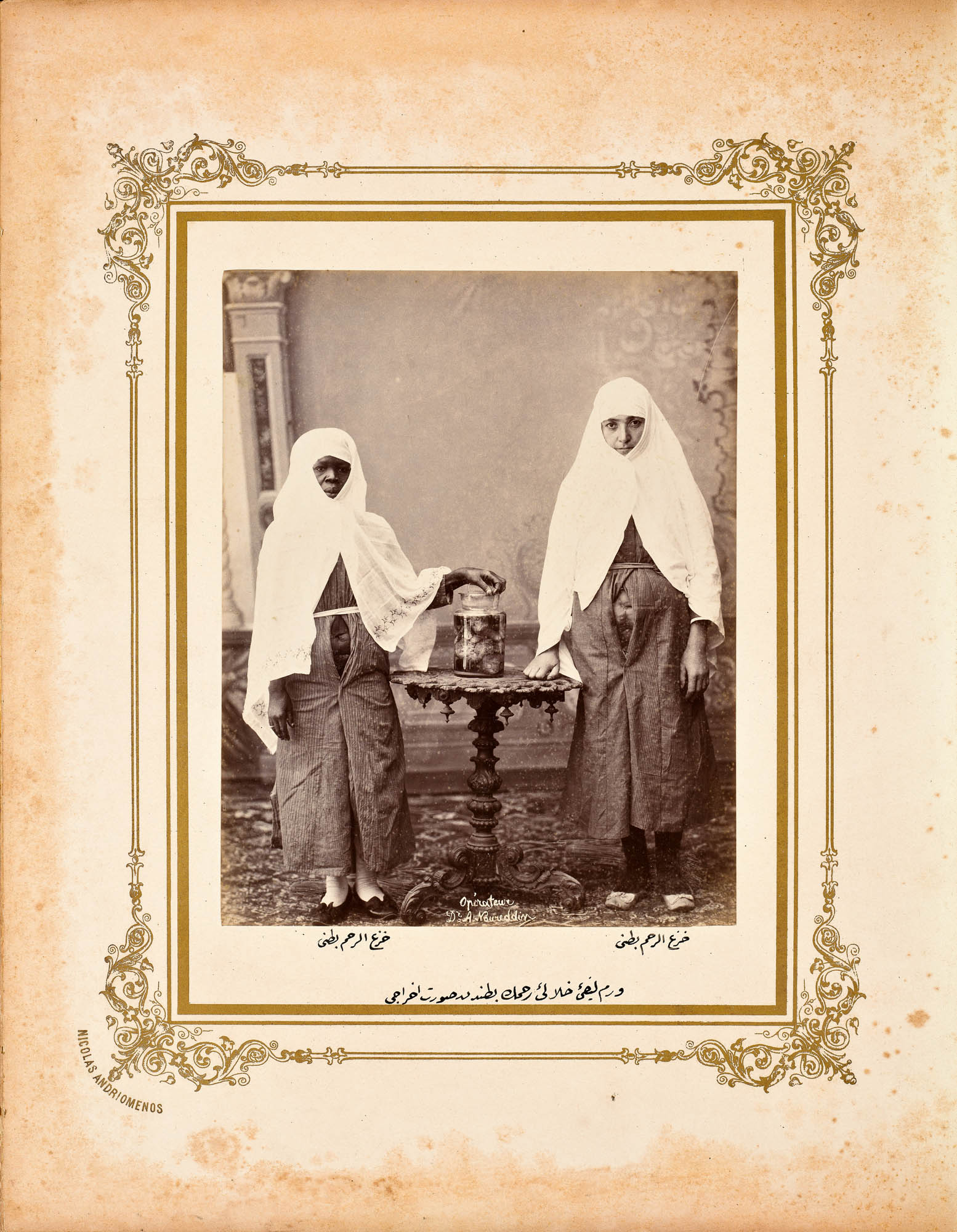 Nicolas Andriomenos, ca.
1893–1907. Image 8, Haseki
Women’s Hospital album, private
collection. One of two photographs
in the album seemingly photographed in Andriomenos’s studio. Photograph not included in the
Haseki portrait album sent to
Yıldız Palace. Courtesy Ömer M. Koç Collection.
Nicolas Andriomenos, ca.
1893–1907. Image 8, Haseki
Women’s Hospital album, private
collection. One of two photographs
in the album seemingly photographed in Andriomenos’s studio. Photograph not included in the
Haseki portrait album sent to
Yıldız Palace. Courtesy Ömer M. Koç Collection.
Next I turned to the architectural record for clues and found that the
early 1890s was a time of big changes for Haseki Hospital. The main
building—the stone house that had been repurposed for patients (Taş
konak)—was torn down in 1890, and the hospital made due in barracks
for a few years before the pavilions that allowed for segregation of
patients according to disease were opened in 1893. I had assumed that
the photographs included in the second album were taken in the hospital
rather than in Andriomenos’s studio. The stone house was a dark build-p. 47 ing with small windows, and prior to the invention of flash it would have
been difficult to make these images in such an interior. The new pavilions
were designed to let in maximum light. When I looked closely at the
images, I saw that what I had taken for a shadow is not a shadow at all but
rather a reflection. The light is coming from a window behind the photographer
and the stove would have been placed close to an interior
rather than external wall. Hence, these must be the reflections of the
doctor and photographer on an interior window giving on to a dark
corridor. When I found the architectural drawings that Patrocle Kampanaki
made for the pavilions in a document dated 1891, the plans showed precisely
such corridors with windows onto the postoperation patient rooms
in the surgery pavilion.25
Figure 23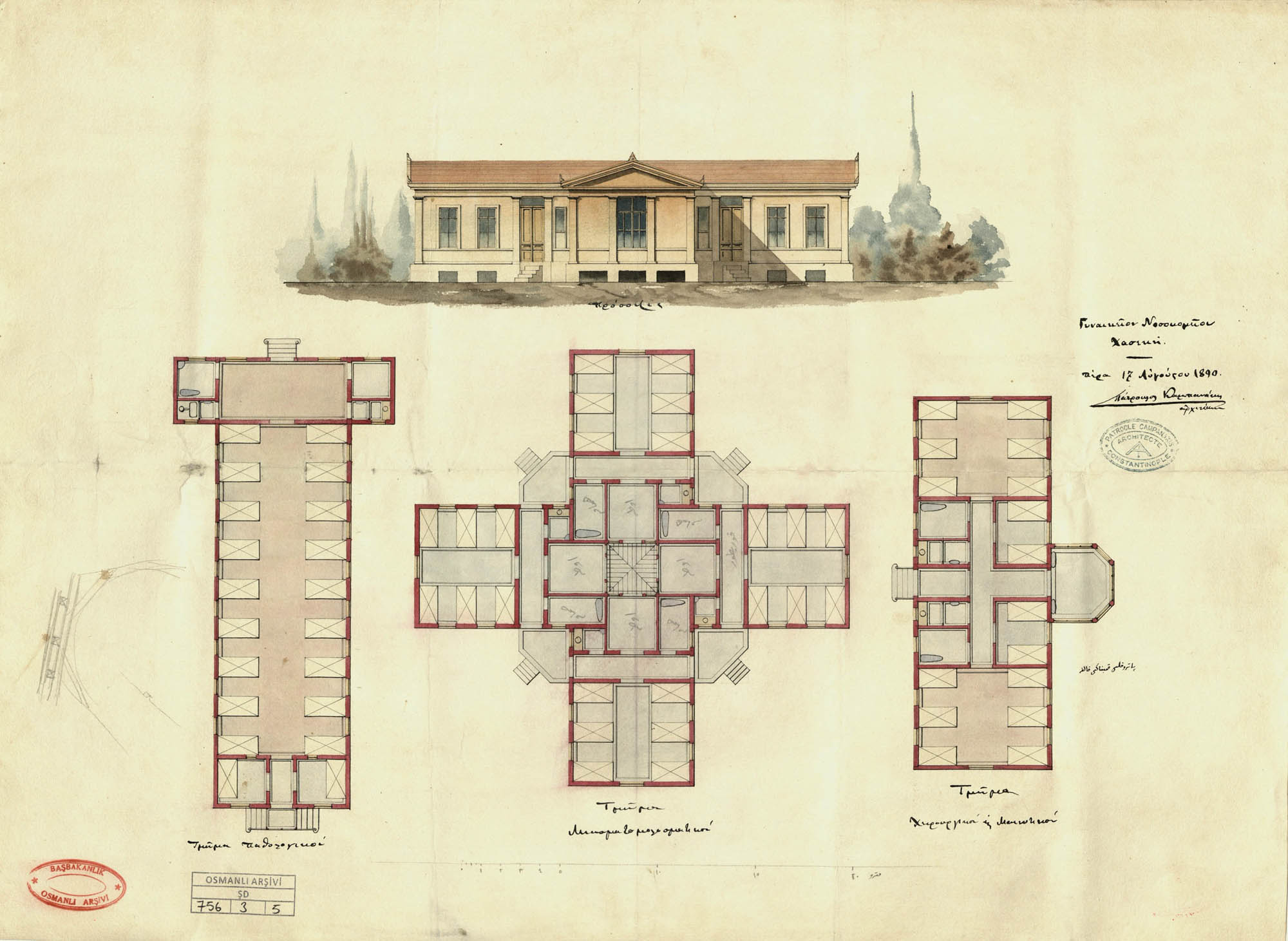 Patrocle Kampanaki.
Architectural plan for Haseki
Women’s Hospital pavilions, 1891.
The plan shows corridors with
windows separating patient
wards from the operating rooms.
Başbakanlık Osmanlı Arşivi
(Prime Ministry Ottoman
Archives).Figure 24
Patrocle Kampanaki.
Architectural plan for Haseki
Women’s Hospital pavilions, 1891.
The plan shows corridors with
windows separating patient
wards from the operating rooms.
Başbakanlık Osmanlı Arşivi
(Prime Ministry Ottoman
Archives).Figure 24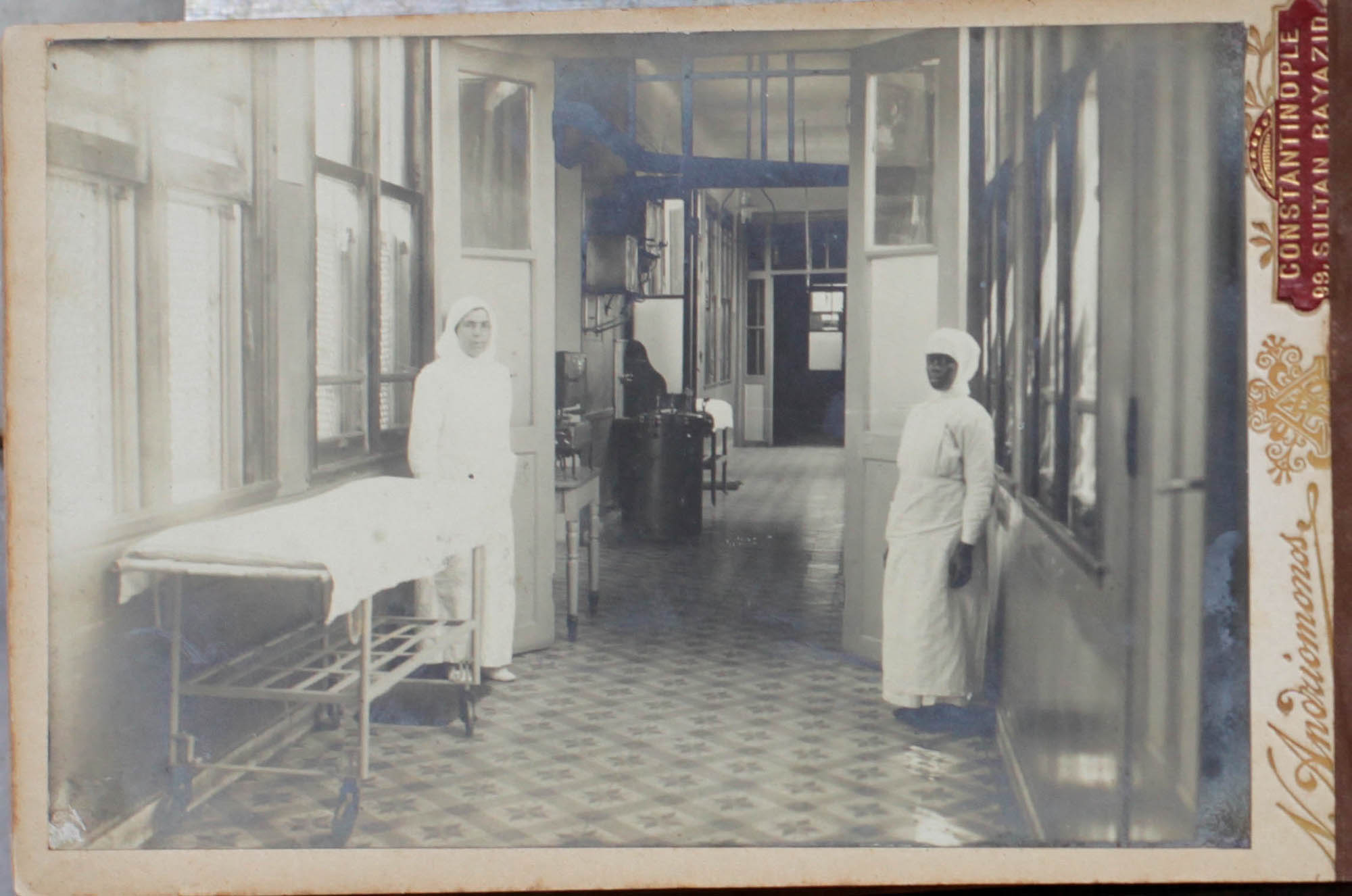 Nicolas Andriomenos.
Photograph showing nurses
standing in a window-lined corridor
of the surgery building at
Haseki Women’s Hospital,
Istanbul, ca. 1914–1924. Courtesy
Refhan Bilol.
Nicolas Andriomenos.
Photograph showing nurses
standing in a window-lined corridor
of the surgery building at
Haseki Women’s Hospital,
Istanbul, ca. 1914–1924. Courtesy
Refhan Bilol.
After much searching I found Dr. Nurettin’s granddaughter (born in
1924, the year he died), and after many teas together she remembered
where she had placed an album of Haseki Hospital, most likely created
during World War I.26 Both the architectural details and floor tiles in the
photographs confirmed my earlier hunches that the additional images
in this second album, now in the collection of Ömer M. Koç, were
taken in the hospital’s new pavilions opened in 1893 rather than in
Andriomenos’s studio.27
The existence of a second album with significant differences from the
album sent to Yıldız Palace proves that the palace album (full of “pictures
of health” that visualize care and captions that underscore healing
and recovery) was deliberately constructed for the sultan. The Haseki
portrait album is undated but was likely produced between the time of
Nurettin’s arrival at the hospital in 1890 and his departure in 1894—
perhaps before the new pavilions opened in 1893, when it became
possible to photograph patients in the hospital.
I kept searching through many photographs of tumors worldwide and
eventually found two examples of comparable photographs taken within
a few years of the Haseki portraits, one from Russia and the other from
China. The Russian “publication”—in which the images are merely glued
to the pages—was prepared by surgeon Ivan Kashkarov in St. Petersburg p. 48 and shows some of the celiotomies he performed from 1889 to 1892.
However, in contrast to the Haseki portraits, the postsurgery women
and the tumors are photographed separately. One patient is photographed holding a presurgery photograph of herself. The scrapbook-like
publication seems intended mostly for other surgeons. In his preface,
Kashkarov writes,
Side by side with good photographs I have had to put poor ones,
because I thought that, much like poor photographs of familiar sites
may evoke in our mind more elevated and lovely images, just in the
same manner some of my lower quality photos are capable to
evoke, by the law of ideational association, good images in the
brains of those who truly love their craft. Another aim of this publication
is instructional, and that could be deduced from my drawings
by any specialist. My last aim is the desire to invite a range of
more artistic images than my photographs, most of which were
taken with rather inexpensive equipment.28
Figure 25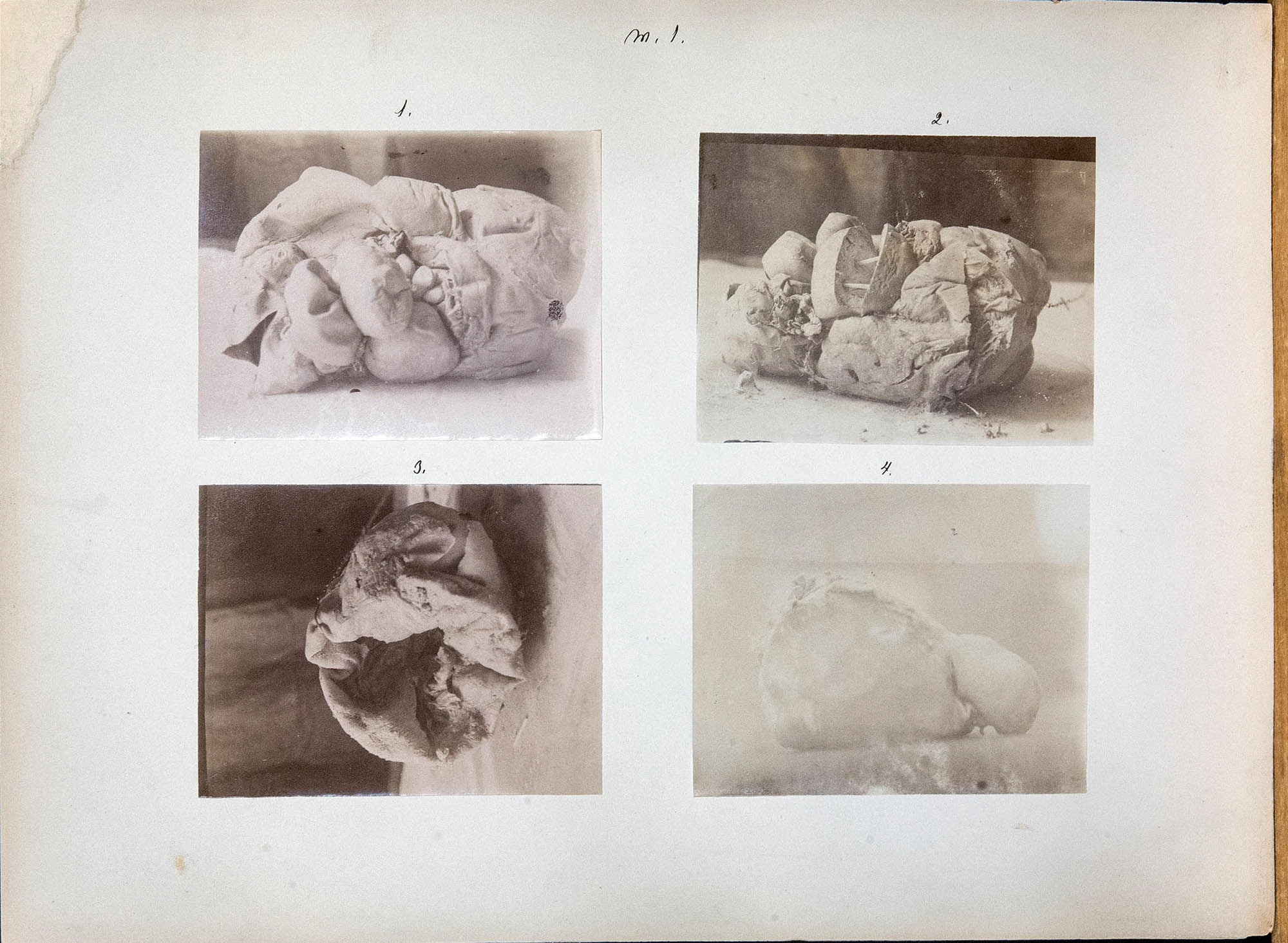 From Ivan Kashkarov,
Klinicheskiya besedy o chrevosecheniyakh
pri boleznyakh
zhenskikh polovykh organov
(Photographic album of laparotomies
in diseases of female
sexual organs; 1893). Courtesy
U.S. National Library of Medicine.Figure 26
From Ivan Kashkarov,
Klinicheskiya besedy o chrevosecheniyakh
pri boleznyakh
zhenskikh polovykh organov
(Photographic album of laparotomies
in diseases of female
sexual organs; 1893). Courtesy
U.S. National Library of Medicine.Figure 26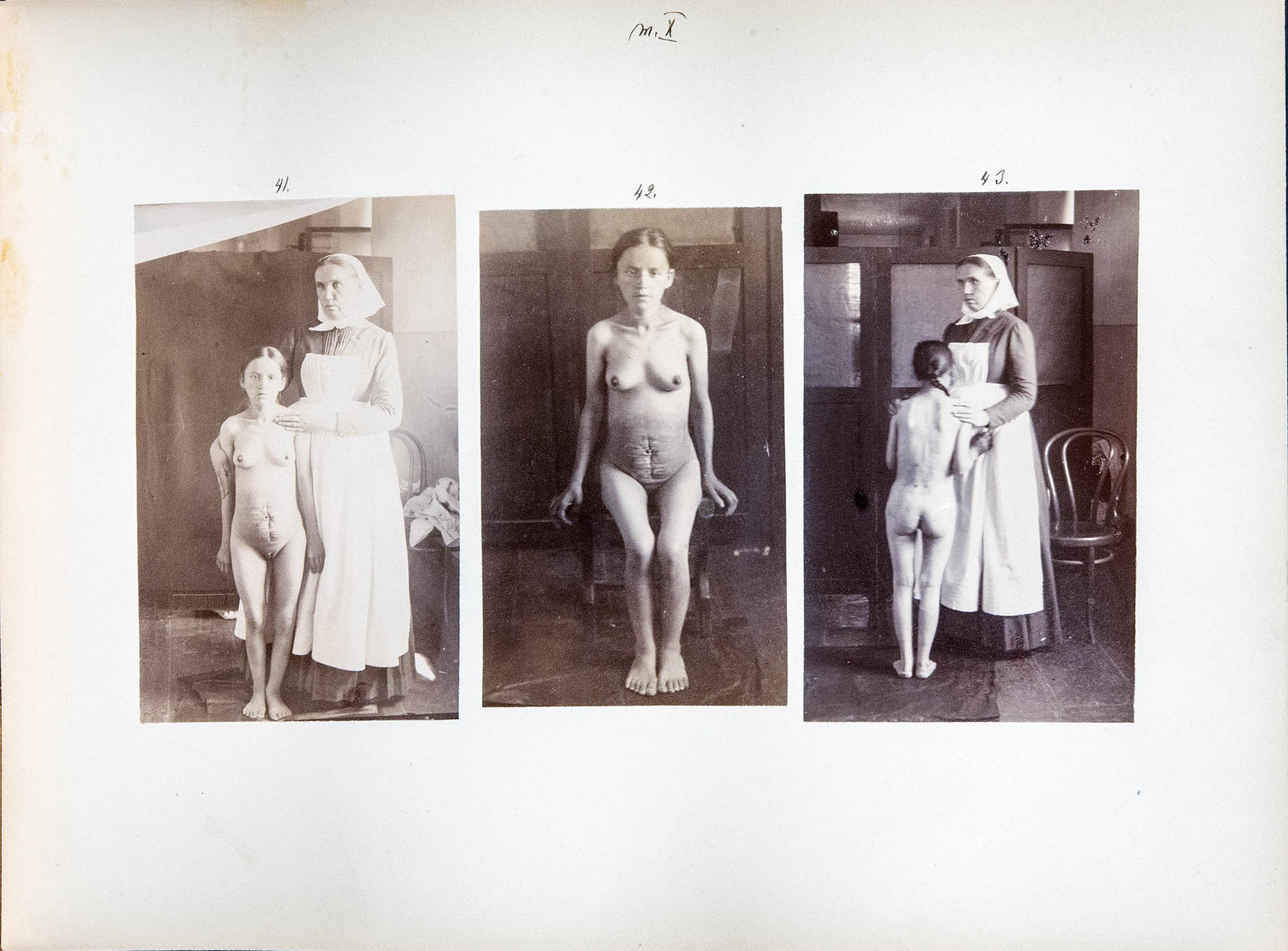 From Ivan Kashkarov,
Klinicheskiya besedy o chrevosecheniyakh
pri boleznyakh
zhenskikh polovykh organov
(Photographic album of laparotomies
in diseases of female
sexual organs; 1893). Courtesy
U.S. National Library of Medicine.
From Ivan Kashkarov,
Klinicheskiya besedy o chrevosecheniyakh
pri boleznyakh
zhenskikh polovykh organov
(Photographic album of laparotomies
in diseases of female
sexual organs; 1893). Courtesy
U.S. National Library of Medicine.
The Chinese example comes from Shanghai. Elizabeth Reifsnyder, a
doctor and medical missionary at the Margaret Williamson Hospital in
Shanghai, sent three images to Philadelphia.29 The first shows Yu Yung
Lan (a twenty-five-year-old married Chinese woman) before her ovariectomy
in 1894. Another photograph shows her two months after the operation.
From a letter giving an annual report of sorts written to a doctor in
Philadelphia on March 31, 1892, we learn that Reifsnyder had been working
in a somewhat rural hospital for some time, but that the Chinese were
still wary of Western doctors. Reifsnyder informs her medical community
back home,
Last year was a special one for us from the fact that two Chinese
women with large ovarian tumors had the courage to be operated
upon, and that in the face of all the opposition they met with from
their friends, relatives and acquaintances. One of the patients is a
Shanghai woman. I will forward her picture by this mail. Thinking p. 49 she might die, before coming to the hospital she had a photographer
come to her house and take her picture. A few days ago she
brought her picture, taken recently, four months after her operation.
I send both copies. Her tumor weighed thirty-seven pounds.30
The Shanghai woman mentioned in this letter is not Yu Yung Lan, whose
tumor weighed 182.5 pounds and was removed in 1894. But the tradition
of photographing patients before and after surgery (started by the patient
mentioned in the 1892 letter) must have continued. Reifsnyder’s letter
assigns a great deal of agency to the Chinese patient for the decisions to
undergo surgery and to be photographed before and after.31
Figure 27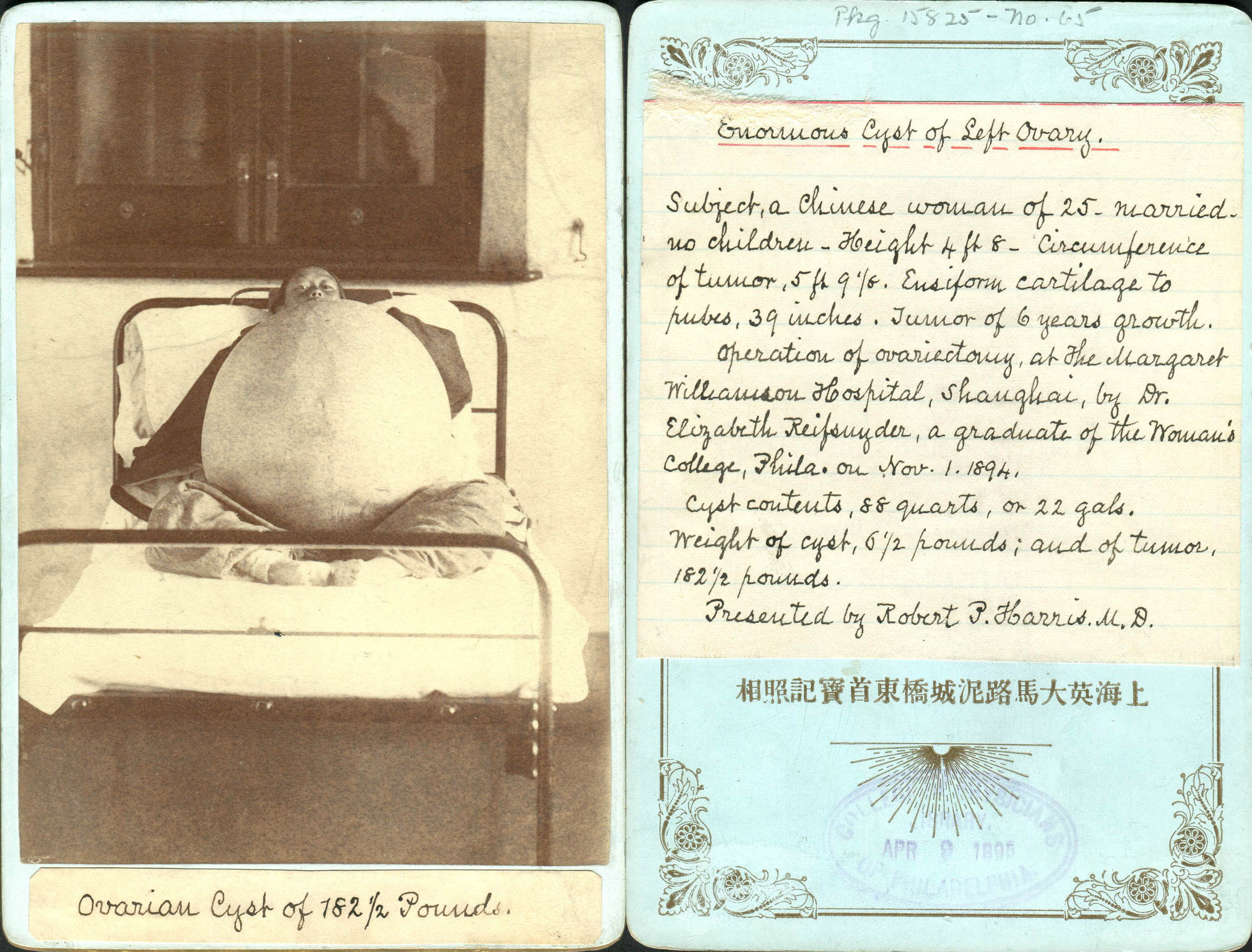 Photographer unknown. “Ovarian Cyst of 182 1/2
Pounds,” 1894. Front and back
views. Courtesy the Historical
Medical Library of the College of
Physicians of Philadelphia.Figure 28
Photographer unknown. “Ovarian Cyst of 182 1/2
Pounds,” 1894. Front and back
views. Courtesy the Historical
Medical Library of the College of
Physicians of Philadelphia.Figure 28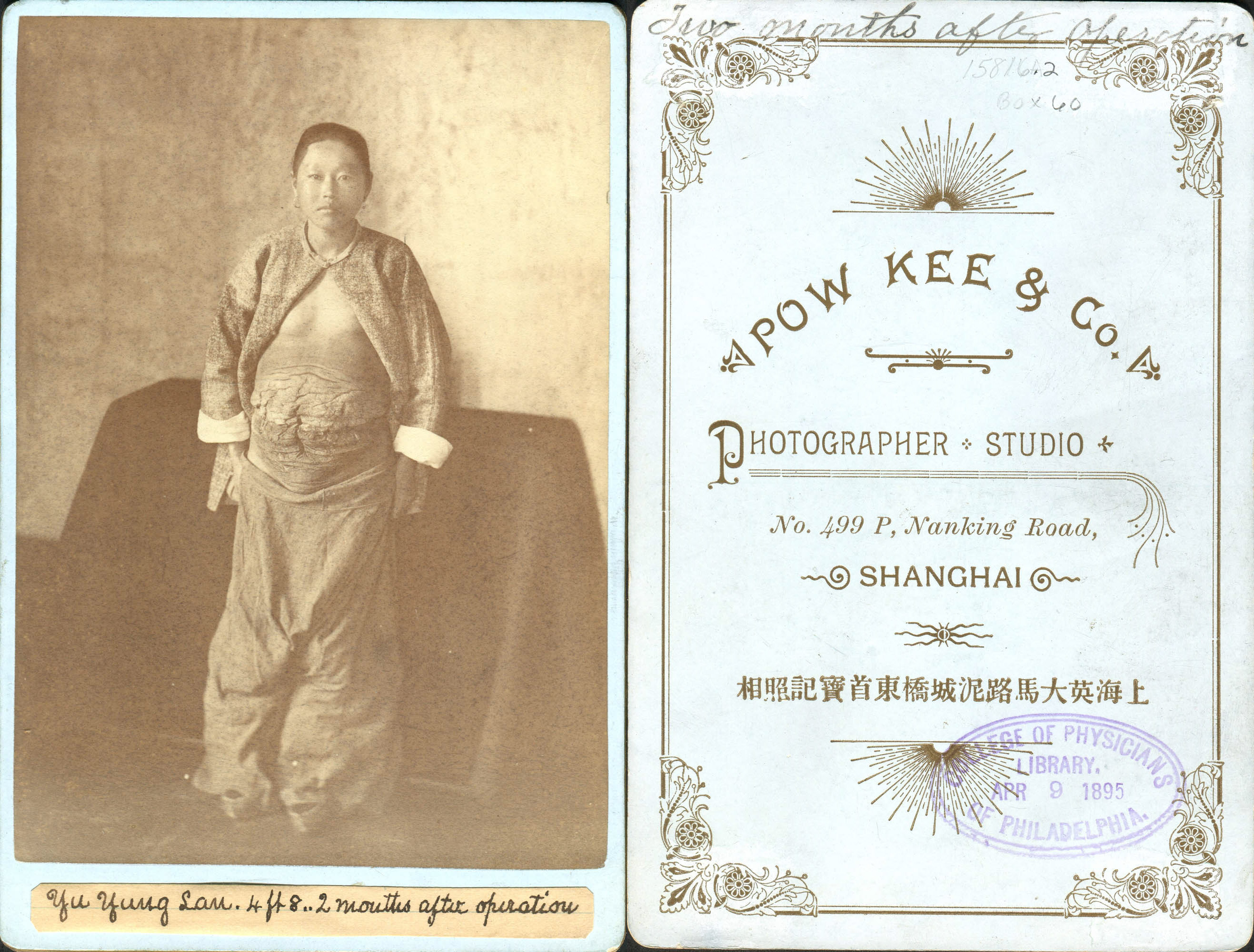 Photographer unknown. “Yu Yung
Lan. 4 ft 8 … 2 months after
operation,” 1895. Front and back
views. Courtesy the Historical
Medical Library of the College of
Physicians of Philadelphia.
Photographer unknown. “Yu Yung
Lan. 4 ft 8 … 2 months after
operation,” 1895. Front and back
views. Courtesy the Historical
Medical Library of the College of
Physicians of Philadelphia.
Returning to the Haseki portrait album, I wondered how we might
make sense of the surgeon’s signature on each plate (and also on each
abdomen in the form of a scar), despite the images having been made by
a prominent studio photographer? How does this album ask us to rethink
agency in photography? The examples from St. Petersburg and Shanghai p. 50 each point to complex webs of power dynamics between patients and
doctors and emerging medical establishments, yet aesthetically they are
much closer to the genre of medical photography of illness or pathological
specimens than to the portraits of Haseki patients taken by Andriomenos.
Still puzzling through why these photographs might have been taken,
I came across a court record of a malpractice case brought against
Nurettin.32 A clerk had charged him with negligence leading to the death
of the clerk’s wife and child during childbirth. The case had been seen a
second time after the clerk appealed the initial ruling, but Nurettin had
eventually been acquitted. Unfortunately, only the acquittal decision,
dated May 8, 1892, remains, so I do not know the date of the tragic incident
or that of the original trial, only that this happened in the two years
prior; that is, in the time that had elapsed since Nurettin’s arrival at the
hospital in 1890. Whether the photographs were produced before, after,
or during the time Nurettin was defending himself against charges of
medical negligence, it is likely that the production of the Haseki portrait
album and the malpractice case overlapped: both correspond to roughly
the same period of the young doctor’s life.
Finally, I found a document in the Ottoman archives dated December
2, 1890, sent from the Ottoman municipal health officer to Sultan
Abdülhamīd confirming that the portrait album was but one way of notifying
the sultan about the successful surgeries Nurettin had performed.
The document tells us about twenty-two-year-old Gülizar Hatun, whose
child had died in the womb:
She was sent to Haseki Hospital last night… . Dr. Ahmed Nurettin
who was on call determined that because her structure was not
suitable there was no natural way to birth the child who had died
two days prior. Upon Dr. Nurettin’s immediately sending word, the
council of doctors met and decided to perform a caesarean. Ahmed
Nurettin was able to perform the surgery in 20 minutes and the
woman in question seemed to be in good health.33
The letter, written the day after the surgery, ends by praising both the surgeon
and the sultan: “Caesareans are important surgeries and are easily
performed by surgeons trained in the medical schools established by his
majesty in hospitals furnished by his majesty. We understand from the
report of the chief doctor of Haseki Hospital that patients offer many
prayers of gratitude to the sultan.”
To put into context Nurettin’s surgical prowess, and the modesty
of the claim that cesareans were easily performed, consider his U.S.
contemporary Howard Kelly. In April 1888, Kelly performed a caesarean
section, the first in Philadelphia in half a century where the mother p. 51 survived. This was hardly seen as an easily performed surgery. Kelly’s
successful completion of three subsequent caesareans was seen as such
an accomplishment that he was named assistant professor of obstetrics
at the University of Pennsylvania’s medical school, and the following year
(at the young age of thirty-one) he was made one of the founding
members—one of the “Big Four”—of the medical faculty of Johns
Hopkins University.34
Prompted by these documents, I went back to Gülizar’s photograph.
And I discovered a clue. Despite having spent seven years working on
the Haseki portrait album, I saw something I had never noticed. What I
now saw had been in plain sight all along, but I had not been able to
detect it as a clue. I had always thought of Gülizar’s portrait as the exception
in the album—the woman alone without that which had been
removed made visible. A photograph without a clear backdrop, perhaps
not taken in the photographer’s studio. Moreover, the photograph had
always seemed less sharp to me than the others. In reality, it was my own
lack of focus that was at issue. For when I looked closely, I saw that the
glass plate had been skillfully doctored by the photographer. Gülizar had
initially been photographed revealing much more than her midriff. The
folds of the front of her gown had been fabricated, complete with an
entirely fictional linchpin that seeks to secure not only Gülizar’s gown
but the propriety of the image.35 Propriety would have been essential for
this gift of photographs to arrive at its destination. Ottoman court historians
told me that the album would have easily passed through the hands
of a dozen clerks before reaching the sultan.
Figure 29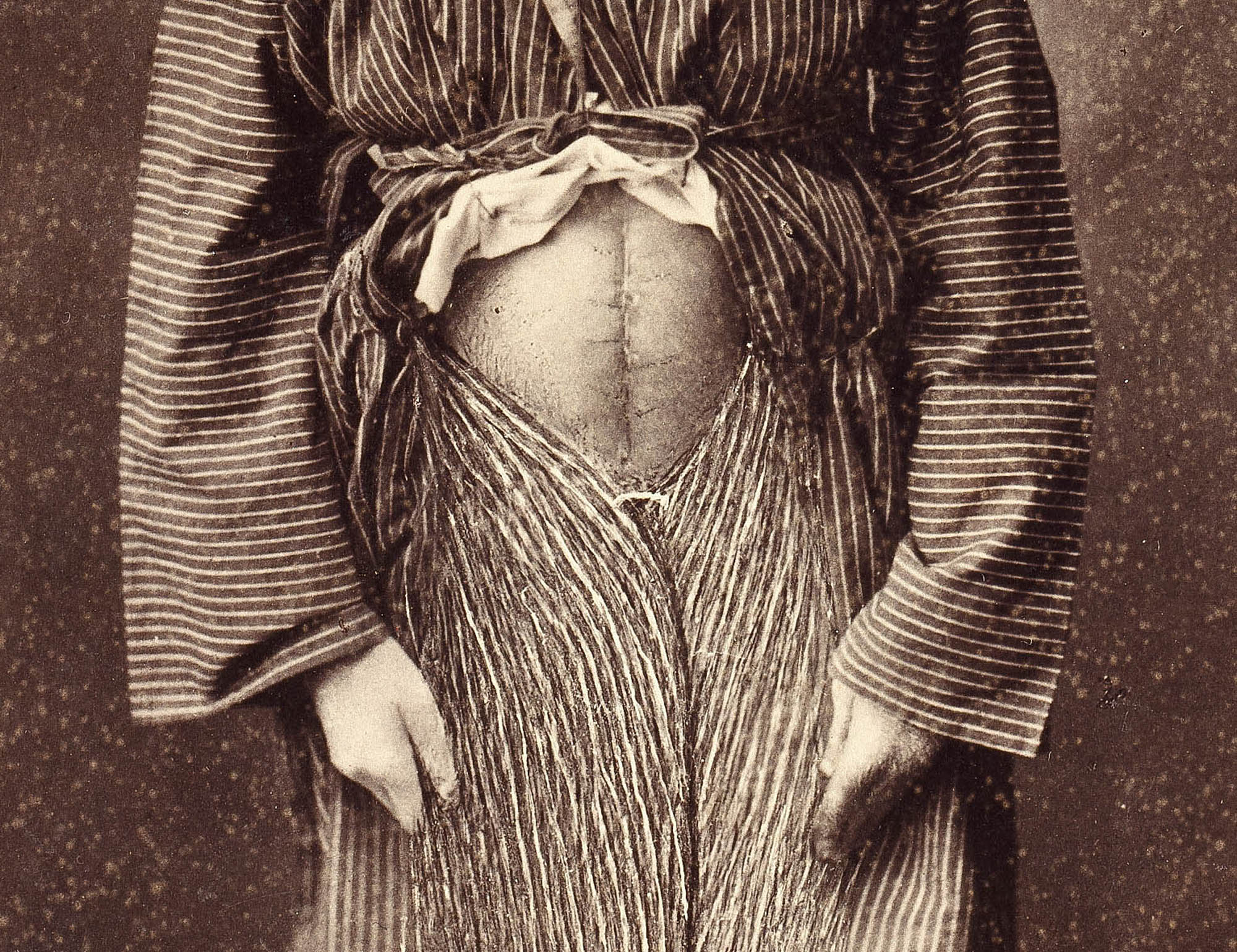 Nicolas Andriomenos or
unknown photographer. Gülizar
Kadın, 1891. Image 4, Haseki
Women’s Hospital album formerly
part of Abdülhamīd II’s Yıldız
Palace collection. Detail showing
that the original glass-plate negative
had been painted over to
close Gülizar’s gown over her
lower body. She had been photographed
holding her gown
open. The area below her scar
and between her hands has been
overpainted to simulate the cloth
of her gown. İstanbul Üniversitesi
Nadir Eserler Kütüphanesi
(Istanbul University Library of
Rare Books).
Nicolas Andriomenos or
unknown photographer. Gülizar
Kadın, 1891. Image 4, Haseki
Women’s Hospital album formerly
part of Abdülhamīd II’s Yıldız
Palace collection. Detail showing
that the original glass-plate negative
had been painted over to
close Gülizar’s gown over her
lower body. She had been photographed
holding her gown
open. The area below her scar
and between her hands has been
overpainted to simulate the cloth
of her gown. İstanbul Üniversitesi
Nadir Eserler Kütüphanesi
(Istanbul University Library of
Rare Books).
Frustrated that I did not know the date of the clerk’s wife dying in
childbirth or the date on which the clerk brought charges of malpractice
against Nurettin, I looked at the photograph for anything that could be
dated. Another visual detail, yet again one that had always been visible,
emerged as a clue. Scars are also time-based media: perhaps a trained eye
could read the time since her surgery in the photograph of Gülizar’s scar.
I consulted with the oldest gynecologists and obstetricians I could find
and asked them to date the women’s surgeries based on how well the
scars had healed. In an attempt to make the process easier, I sent digital p. 51 copies of the images and asked them to zoom in on the surgery scars. They told me the photographs were not taken immediately after the surgeries
but rather at least three months after the incisions had been made.36
Historical records talk about some poor patients at Haseki staying for
lengthy recoveries, often because they had nowhere to go. The document
sent to the palace the morning after Gülizar’s caesarean mentions that
she had been sent over from the shelter for poor women without specifying
whether this was the hospital’s own shelter or another municipal
women’s shelter.37 Gülizar might not have returned to the hospital to
pose for her photograph because she might never have left. Gülizar’s photograph
in the album sent to the sultan indexes several moments of time:
the night of the surgery, the day the photograph was made, the moment
it was carefully doctored, and the decision to include it in the album
with the portraits of women and their tumors.
For a while I was content. The doctor and the photographer had made
a bold choice to photograph this young woman fully exposed upon
recovery from her surgery to reflect the surgeon’s exceptional skill: At a
time when surviving a caesarean was by no means guaranteed, here
stood Gülizar as a picture of health. Gülizar’s is the only portrait whose
caption even in the second nonidentical album includes the descriptor
“picture of health.” Had the doctor and photographer taken the photograph
without any intent to send it and then doctored it later for the eyes
of the sovereign? Or in anticipation of the many others whose eyes the
album would pass before reaching the sovereign? Perhaps this had been
the first portrait made in the series?
Yet something nagged at me at night. Social norms do not change
overnight. Nurettin almost certainly knew of the difficulties encountered
by the former director of Haseki hospital, Kiryako, the young doctor who
was accused of looking inappropriately at his Muslim female patients.
Kiryako’s ordeal had ended with him being reinstated as chief doctor just
five years before Gülizar’s surgery. Would taking a photograph of an
exposed Gülizar not have been considered dangerous? The malpractice
suit brought by the clerk against Nurettin almost certainly predates the
moment the photographer and doctor photographed Gülizar. Would
Nurettin not have been especially cautious to avoid arousing suspicions
during such a trial?
I sought out a newly retired gynecologist, this time in Istanbul. He
remembered visiting Haseki during his own medical training and seeing
the album (presumably the copy once owned by the hospital) on the desk
of the chief doctor. He described admiring Nurettin’s surgical skills even
many decades after the images had been made. This time, however, I did
not zoom in on Gülizar’s scar and ask him to date it. I showed him the p. 53 full image and shared the document sent to the palace the day after
describing the surgery. An amateur medical historian as well as a doctor,
he immediately asked a question I had not considered, thereby pointing
out yet another clue: Why would the doctors risk Gülizar’s life by performing
a caesarean if the child had already died? “The risks of infection
at the time were so great,” he said, “that the first rule to even consider a
caesarean was confirmation that the child was still alive. Why would Dr.
Nurettin ever attempt such an irresponsible surgery? There must have
been a reason.”
There was. The doctor looked again carefully at the portrait of Gülizar—
not just a zoomed-in image of her surgical scar—but her full portrait. “Of
course! Look at her posture and her miniature stature. This girl had
rickets,” he stated confidently. Her pelvis must have been so deformed, he
concluded, that even if they crushed the child in utero—craniotomy was
the standard way that such a stillborn child would be delivered at the
time—the doctors could not have removed the fetus vaginally.38 Nurettin
performed the caesarean despite the fetus being confirmed dead two
days prior—not at the risk of, but as the only way to save, Gülizar’s life.39
Perhaps it was precisely because he was already being investigated for
malpractice, or at the very least because the judicial system allowed
for such malpractice cases at the time, that Nurettin initially asked the
photographer Andriomenos to take the photograph of Gülizar in a manner
that fully exposed her highly deformed pelvic structure to show not
only that she had survived and was a picture of health but also to explain
why he had undertaken this surgery in defiance of the medical protocols
of the day. Then at some later point Nurettin (or perhaps the photographer
Andriomenos, or perhaps both together) decided it was important
that Gülizar’s photograph as a picture of health be included in the album
on tumors addressed to the sultan. After all, her case had already been
mentioned to him in a letter. But before including the photograph, they
took the precaution of re-dressing her.
Even now, when I can see beyond the fabricated hospital uniform
covering Gülizar’s disfigured pelvis and surmise the set of conditions
that led to her portrait being presented to the sultan in precisely this
manner, I can conclude only by sharing some questions. Some I can venture
to answer; others I can only ask in the hopes that answers might be
unearthed when new clues emerge.40 How is care being visualized in this
album and to what political end? Does the appearance of these images in
an album at the sultan’s palace collapse traditional differences between
medical and political images? What might have been the impact of these
images that show the removal of tumors and serve as testimonies to the
efficacy of medical interventions?
p. 53 Perhaps the images in the Haseki album were a preemptive effort to
protect Nurettin against charges of improper treatment of Muslim
women—such as those brought against his Greek Ottoman predecessor,
Kiryako. After all, each photograph grants indigent women some of the
aesthetic dignity afforded to women of means, those able to commission
their portrait in a prominent photography studio.41
Perhaps the photographs were a visual defense case, a lineup of proof
of Nurettin’s prowess as a surgeon that might serve as insurance against
any malpractice claims brought against him. Nurettin was indeed acquitted
in the malpractice case that concluded in 1892. Moreover, when he
petitioned to travel to Paris for three months at his own expense to study
the latest treatments of diphtheria with the physician Émile Roux in late
1894, he was granted permission.42 Neither the malpractice case nor
any suspicions that might have arisen about his decision to perform a
caesarean on Gülizar given the known death of the fetus seems to have
prevented Nurettin from rising quickly in the ranks.
Perhaps the portraits were intended to proudly display for the sovereign
the results of Nurettin’s surgical talents, to boast of the extraordinary
surgeries performed by a young doctor. After all, Nurettin was
merely twenty-four when he performed the caesarean on Gülizar.43 Upon
his return from Paris, he studied general surgery at Gureba Hospital with
a prominent Ottoman surgeon who had trained in France, and eventually
returned to Haseki in 1903, where he was promoted to hospital
director in 1907.44 Moreover, not only did he have a successful career in
surgery; he was held in high esteem within the medical establishment
and beyond and served in several leadership roles in emerging public
health organizations, such as the Müessesât-ı Hayriye-i Sıhhiye İdaresi
(Administration of Medical Charities in Istanbul).45 According to his
granddaughter, Nurettin was also called on to care for women in the
royal family.46
Perhaps the album served as visual evidence of the miracles of modern
science and the lives being saved in the Ottoman Empire’s hospitals. p. 55 A 1907 document strongly endorsing Nurettin for the directorship of
Haseki Hospital includes a table listing all 121 surgeries performed at the
hospital of which only one resulted in a death.47 These near-perfect
results are deemed to be worthy of the glory of the Ottoman Empire and
the sultan himself, and hence the surgeon’s talents are presented at the
service of the empire’s reputation. A second table sent in June that same
year details surgeries performed since the first report and includes four
photographs showing patients after their recovery.48 Attention is drawn
to the surgery shown in one of the photographs, deemed to be a particularly
critical surgical intervention. Another album
sent to the palace and titled “Patients who have
undergone surgery” includes nine prints showing
recovering patients and opens with a photograph
taken during surgery itself.49 That print is followed
by one in which the patient being operated
on in the prior photograph, Hüseyin of Arapkir, is
baring his midriff, pointing to his scar with his left
hand while holding in his right hand his removed
spleen, which weighed just over five kilograms.50
The caption emphasizes the extreme rarity and
importance of a patient surviving the surgery and
living without a spleen.51
Figure 30 Unknown photographer. View
of an operation on the patient
Hüseyin at Haseki Women’s
Hospital, Istanbul, ca. 1903–1907.
First image in Ameliyat-I
Cerrahiye İcra Olunan Bazı
Hastalar (Patients who have
undergone surgery), formerly part
of Abdülhamīd II’s Yıldız Palace
collection. İstanbul Üniversitesi
Nadir Eserler Kütüphanesi
(Istanbul University Library of
Rare Books).Figure 31
Unknown photographer. View
of an operation on the patient
Hüseyin at Haseki Women’s
Hospital, Istanbul, ca. 1903–1907.
First image in Ameliyat-I
Cerrahiye İcra Olunan Bazı
Hastalar (Patients who have
undergone surgery), formerly part
of Abdülhamīd II’s Yıldız Palace
collection. İstanbul Üniversitesi
Nadir Eserler Kütüphanesi
(Istanbul University Library of
Rare Books).Figure 31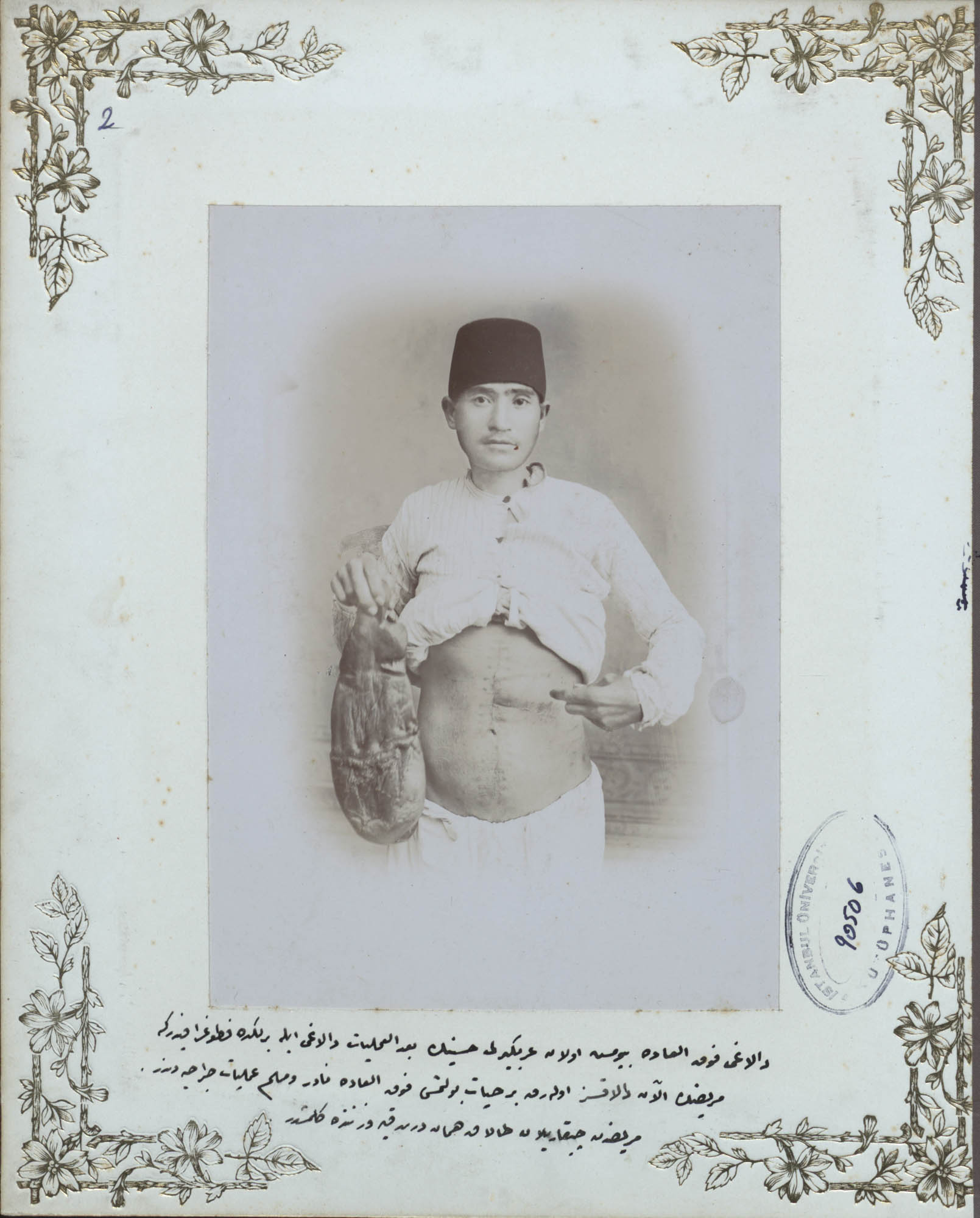 Unknown photographer. Hüseyin
pointing to his scar with his left
hand while holding in his right
hand his removed spleen, ca.
1903–1907. Second image in
Ameliyat-I Cerrahiye İcra Olunan
Bazı Hastalar (Patients who have
undergone surgery), formerly part
of Abdülhamīd II’s Yıldız Palace
collection, showing the result of
the operation depicted in the first
image. İstanbul Üniversitesi Nadir
Eserler Kütüphanesi (Istanbul
University Library of Rare Books).Figure 32
Unknown photographer. Hüseyin
pointing to his scar with his left
hand while holding in his right
hand his removed spleen, ca.
1903–1907. Second image in
Ameliyat-I Cerrahiye İcra Olunan
Bazı Hastalar (Patients who have
undergone surgery), formerly part
of Abdülhamīd II’s Yıldız Palace
collection, showing the result of
the operation depicted in the first
image. İstanbul Üniversitesi Nadir
Eserler Kütüphanesi (Istanbul
University Library of Rare Books).Figure 32 Unknown photographer. Hüseyin
pointing to his scar with his left
hand while holding in his right
hand his removed spleen, ca.
1903–1907. Second image in
Ameliyat-I Cerrahiye İcra Olunan
Bazı Hastalar (Patients who have
undergone surgery), formerly part
of Abdülhamīd II’s Yıldız Palace
collection, showing the result of
the operation depicted in the first
image. This copy of the photograph,
mounted on a pink card
and bearing the imprint of Greek
Ottoman photographer Theodore
Vafiadis, is part of a set of images
of postoperative patients sent to
Ottoman municipal health officials.
Başbakanlık Osmanlı Arşivi
(Prime Ministry Ottoman
Archives).
Unknown photographer. Hüseyin
pointing to his scar with his left
hand while holding in his right
hand his removed spleen, ca.
1903–1907. Second image in
Ameliyat-I Cerrahiye İcra Olunan
Bazı Hastalar (Patients who have
undergone surgery), formerly part
of Abdülhamīd II’s Yıldız Palace
collection, showing the result of
the operation depicted in the first
image. This copy of the photograph,
mounted on a pink card
and bearing the imprint of Greek
Ottoman photographer Theodore
Vafiadis, is part of a set of images
of postoperative patients sent to
Ottoman municipal health officials.
Başbakanlık Osmanlı Arşivi
(Prime Ministry Ottoman
Archives).
These later postoperative and before-and-after
surgery images are useful comparisons to the Haseki
portrait album Nurettin prepared and sent to the
palace in the early 1890s. The later images are
proof that by the first decade of the twentieth century
the genre of surgical photography had consolidated
and become a well-known convention.
Patients are still sometimes identified by name
and place of origin, but these images are no longer
captioned poetically as pictures of health or landscapes
of healing, and they cannot be mistaken for
commissioned studio portraits. While visible
backdrops in some of the photographs suggest
they were taken in prominent Greek photographer
Theodore Vafiadis’s studio, they are stylistically
much more akin to images illustrating accomplishments
in surgery published in journals such
as Revue de photographie médicale or Photography
and Surgery.52 With the exception of the spleen held
by the patient from whom it has been removed, p. 56 tumors or organs removed from the patients are no longer displayed. Gone are the tumors in bell jars on decorative tables. However, the album
of surgery patients sent to the palace includes a print showing a woman
who had survived a caesarean delivery holding a swaddled baby of
several months.
The Turkish gynecologist I consulted with had been deeply impressed
when he was new to the profession and viewed the Haseki portrait
album, suggesting it may have been used as a pedagogical tool. Ottoman
medical students in the nineteenth century learned childbirth by using
charts and illustrations rather than attending actual births. Besim Ömer,
the pioneer of Ottoman obstetrics and gynecology, was not permitted to
establish an official maternity clinic upon his return to Istanbul in 1891
from Paris, where he had been trained. Therefore, he opened an undercover
clinic where young obstetricians learned the basics of their craft by
practicing on the bodies of destitute women.53 One of the allegations
brought against Kiryako that was found to have some validity was that
young doctors and midwives came to Haseki to watch childbirths.
Hence, perhaps the Haseki portrait album was a permissible pedagogical
tool in a climate where offering or receiving medical training could leave
a doctor exposed to charges of impropriety. One indication that the
album may have been seen by other doctors at the time is a photograph
showing a woman who survived a caesarean in 1898, this time photographed
with her baby.54 This cesaerean was performed not by Nurettin
but by Besim Ömer, the young gynecologist making a name for himself at
the time. Similarly, the photograph is signed with his name in 1903. The
resonance between this image and the photograph showing another
woman’s recovery from a caesarean performed at Haseki Hospital suggests
Ömer and Nurettin were aware not only of one another’s surgeries but of
one another’s photographic practices.
Figure 34 Unknown photographer.
Photograph showing a healthy
recovery from a caesarean delivery,
1903. From Fotoğraf albümü: Yıldız
Sarayı, insan fotoğrafları, vazo,
kaide ve çeşitli bina fotoğrafları
(Yıldız Palace, portraits, vases,
pedestals, and architectural photographs).
The caption is penned
by the obstetrician Besim Ömer.
Courtesy Halife Abdülmecid
Efendi Library Collection,
Dolmabahçe Palace, Istanbul.
Unknown photographer.
Photograph showing a healthy
recovery from a caesarean delivery,
1903. From Fotoğraf albümü: Yıldız
Sarayı, insan fotoğrafları, vazo,
kaide ve çeşitli bina fotoğrafları
(Yıldız Palace, portraits, vases,
pedestals, and architectural photographs).
The caption is penned
by the obstetrician Besim Ömer.
Courtesy Halife Abdülmecid
Efendi Library Collection,
Dolmabahçe Palace, Istanbul.
Perhaps the Haseki portrait album was
circulated as a subtle means of showing
gratitude and requesting further funds,
since the sovereign was central to the distribution
of resources? Perhaps the letter
written to the palace the day after Gülizar’s
cesaerean which underscored that caesarean
deliveries could be easily performed
was intended to emphasize that as long
as the sultan continued his financial support
of the empire’s hospitals and medical
school, Ottoman surgeons could effectively
perform the most challenging surgeries. p. 57 The good work of surgeons is seen as a means of augmenting the reputation
of the sultan as kind and benevolent and caring of his subjects. What
the letter reflected back to the sultan was that surviving patients offered
prayers of gratitude not only to their doctors but to the sultan responsible
for the establishment of hospitals and the training of doctors.
Finally, the album was perhaps also intended as a medical argument
for the effectiveness of asepsis. All of the photographed women had survived
a surgery that, due to the high risk of infection at the time, could
be as deadly if not more deadly than the tumors that had led to the need
for operation. The French physician Roux (with whom Nurettin studied
in Paris in 1894) was a major proponent of asepsis, a technique by which
medical facilities—and operating rooms in particular—are kept free of
disease-causing filth. Soon after he arrived as a junior doctor at the hospital
(and thus before he went to Paris), Nurettin, while still the same
rank as when he must have prepared the Haseki portrait album, wrote a
report on the merits of the pavilion system whereby patients are separated
by disease so as to minimize infection.55 This report, endorsed by
the more senior doctors in the hospital, led to the construction of Haseki’s
pavilions.56 Hence, the Haseki portrait album may also have been part of
a persuasive plea for changes in medical curricula and hospital architecture
most conducive to effective surgical hygiene.57 Nurettin eventually
headed a commission for public health policy in Istanbul charged with
effectively preventing and containing the spread of infectious diseases.
Regardless of Andriomenos’s or Nurettin’s initial intentions, the visualization
of care in the Haseki portrait album made many arguments
simultaneously: establishing prestige, protecting and augmenting reputations,
protecting professional standing, fund-raising, advocating for
certain medical procedures and architecture, illustrating modernity, reifying
sovereign power, subjecting to scrutiny but
also dignifying indigent women, and managing
competing proprieties (religious and cultural
norms versus medical norms).
There is no single discovery at the conclusion
of this detective narrative. Rather, I have
tried to show how clues became detectable
over nearly a decade of investigation. Asking
the same question in multiple ways, with multiple
tools and by consulting multiple sources
and experts can help us as scholars see afresh
rather than merely confirm what we believe
we have already seen. The Haseki portrait
album required that I look closely not only at p. 58 each image but take seriously the album as an object and a collection of
images. Many of the clues in this research emerged only when I moved
away from both single images and the broad category of medical photography
and considered how the album might have been constructed or
through what routes it circulated. Genres can be powerful clues if, rather
than serve as fixed identification charts to hold images up to, they provoke
us to ask under what conditions they emerged. The Haseki portrait album
illustrates the unsettlement that characterizes the period before a genre
is consolidated. Photographs rarely conform to strict genre conventions,
and precisely in the places where they do not—where different conventions
clash or where deviations or dissonances can be detected as clues—we
can begin to see new kinds of formations emerging or investigate unresolved
tensions over competing demands for visibility and propriety.
In the process of preparing the images in this article for publication,
I detected, perhaps fittingly, one final clue. Looking upon Gülizar’s portrait
again, this time in conversation with a photographer knowledgeable
about historical processes, we noticed that the glass plate had been
signed before “Dr. A. Noureddin” was carefully written in the corner.
The simple statement “your servant doctor” (tabip kulları) seems to have
been etched into the glass plate before the doctor’s signature. I cannot be
certain of this, for efforts have been made to erase the writing both above
Nurettin’s signature and that to the left of Gülizar. The letters on the left
suggest the name of a photographer, though one that has not appeared in
my searches in the archives. Perhaps Nurettin asked a less-well-known
photographer (maybe even one without his own studio) to take the original
photograph of Gülizar baring her twisted pelvis to serve as evidence
for what had necessitated the unconventional caesarean. Perhaps this was
prompted by a malpractice suit. However, when the decision was made
to doctor the image, perhaps the original photographer did not have the
proper skills and Nurettin approached Andriomenos (one of the prominent
portraitists of the era) not to make a photograph but to remake one
taken by another photographer into an image that could be circulated.
Perhaps that encounter sparked the larger collaboration that resulted in
the Haseki portrait album.





















